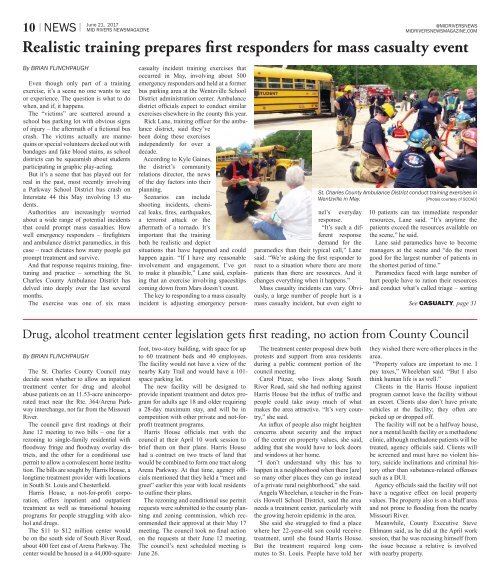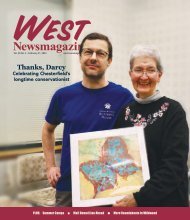Mid Rivers Newsmagazine 6-21-17
Local news, local politics and community events for St. Charles County Missouri.
Local news, local politics and community events for St. Charles County Missouri.
Create successful ePaper yourself
Turn your PDF publications into a flip-book with our unique Google optimized e-Paper software.
10 I NEWS I<br />
June <strong>21</strong>, 20<strong>17</strong><br />
MID RIVERS NEWSMAGAZINE<br />
@MIDRIVERSNEWS<br />
MIDRIVERSNEWSMAGAZINE.COM<br />
Realistic training prepares first responders for mass casualty event<br />
By BRIAN FLINCHPAUGH<br />
Even though only part of a training<br />
exercise, it’s a scene no one wants to see<br />
or experience. The question is what to do<br />
when, and if, it happens.<br />
The “victims” are scattered around a<br />
school bus parking lot with obvious signs<br />
of injury – the aftermath of a fictional bus<br />
crash. The victims actually are mannequins<br />
or special volunteers decked out with<br />
bandages and fake blood stains, as school<br />
districts can be squeamish about students<br />
participating in graphic play-acting.<br />
But it’s a scene that has played out for<br />
real in the past, most recently involving<br />
a Parkway School District bus crash on<br />
Interstate 44 this May involving 13 students.<br />
Authorities are increasingly worried<br />
about a wide range of potential incidents<br />
that could prompt mass casualties. How<br />
well emergency responders – firefighters<br />
and ambulance district paramedics, in this<br />
case – react dictates how many people get<br />
prompt treatment and survive.<br />
And that response requires training, finetuning<br />
and practice – something the St.<br />
Charles County Ambulance District has<br />
delved into deeply over the last several<br />
months.<br />
The exercise was one of six mass<br />
casualty incident training exercises that<br />
occurred in May, involving about 500<br />
emergency responders and held at a former<br />
bus parking area at the Wentzville School<br />
District administration center. Ambulance<br />
district officials expect to conduct similar<br />
exercises elsewhere in the county this year.<br />
Rick Lane, training officer for the ambulance<br />
district, said they’ve<br />
been doing these exercises<br />
independently for over a<br />
decade.<br />
According to Kyle Gaines,<br />
the district’s community<br />
relations director, the news<br />
of the day factors into their<br />
planning.<br />
Scenarios can include<br />
shooting incidents, chemical<br />
leaks, fires, earthquakes,<br />
a terrorist attack or the<br />
aftermath of a tornado. It’s<br />
important that the training<br />
both be realistic and depict<br />
situations that have happened and could<br />
happen again. “If I have any reasonable<br />
involvement and engagement, I’ve got<br />
to make it plausible,” Lane said, explaining<br />
that an exercise involving spaceships<br />
coming down from Mars doesn’t count.<br />
The key to responding to a mass casualty<br />
incident is adjusting emergency personnel’s<br />
everyday<br />
response.<br />
“It’s such a different<br />
response<br />
demand for the<br />
paramedics than their typical call,” Lane<br />
said. “We’re asking the first responder to<br />
react to a situation where there are more<br />
patients than there are resources. And it<br />
changes everything when it happens.”<br />
Mass casualty incidents can vary. Obviously,<br />
a large number of people hurt is a<br />
mass casualty incident, but even eight to<br />
St. Charles County Ambulance District conduct training exercises in<br />
Wentzville in May.<br />
[Photos courtesy of SCCAD]<br />
10 patients can tax immediate responder<br />
resources, Lane said. “It’s anytime the<br />
patients exceed the resources available on<br />
the scene,” he said.<br />
Lane said paramedics have to become<br />
managers at the scene and “do the most<br />
good for the largest number of patients in<br />
the shortest period of time.”<br />
Paramedics faced with large number of<br />
hurt people have to ration their resources<br />
and conduct what’s called triage – sorting<br />
See CASUALTY, page 31<br />
Drug, alcohol treatment center legislation gets first reading, no action from County Council<br />
By BRIAN FLINCHPAUGH<br />
The St. Charles County Council may<br />
decide soon whether to allow an inpatient<br />
treatment center for drug and alcohol<br />
abuse patients on an 11.53-acre unincorporated<br />
tract near the Rte. 364/Arena Parkway<br />
interchange, not far from the Missouri<br />
River.<br />
The council gave first readings at their<br />
June 12 meeting to two bills – one for a<br />
rezoning to single-family residential with<br />
floodway fringe and floodway overlay districts,<br />
and the other for a conditional use<br />
permit to allow a convalescent home institution.<br />
The bills are sought by Harris House, a<br />
longtime treatment provider with locations<br />
in South St. Louis and Chesterfield.<br />
Harris House, a not-for-profit corporation,<br />
offers inpatient and outpatient<br />
treatment as well as transitional housing<br />
programs for people struggling with alcohol<br />
and drugs.<br />
The $11 to $12 million center would<br />
be on the south side of South River Road,<br />
about 400 feet east of Arena Parkway. The<br />
center would be housed in a 44,000-squarefoot,<br />
two-story building, with space for up<br />
to 60 treatment beds and 40 employees.<br />
The facility would not have a view of the<br />
nearby Katy Trail and would have a 101-<br />
space parking lot.<br />
The new facility will be designed to<br />
provide inpatient treatment and detox program<br />
for adults age 18 and older requiring<br />
a 28-day maximum stay, and will be in<br />
competition with other private and not-forprofit<br />
treatment programs.<br />
Harris House officials met with the<br />
council at their April 10 work session to<br />
brief them on their plans. Harris House<br />
had a contract on two tracts of land that<br />
would be combined to form one tract along<br />
Arena Parkway. At that time, agency officials<br />
mentioned that they held a “meet and<br />
greet” earlier this year with local residents<br />
to outline their plans.<br />
The rezoning and conditional use permit<br />
requests were submitted to the county planning<br />
and zoning commission, which recommended<br />
their approval at their May <strong>17</strong><br />
meeting. The council took no final action<br />
on the requests at their June 12 meeting.<br />
The council’s next scheduled meeting is<br />
June 26.<br />
The treatment center proposal drew both<br />
protests and support from area residents<br />
during a public comment portion of the<br />
council meeting.<br />
Carol Pitzer, who lives along South<br />
River Road, said she had nothing against<br />
Harris House but the influx of traffic and<br />
people could take away much of what<br />
makes the area attractive. “It’s very country,”<br />
she said.<br />
An influx of people also might heighten<br />
concerns about security and the impact<br />
of the center on property values, she said,<br />
adding that she would have to lock doors<br />
and windows at her home.<br />
“I don’t understand why this has to<br />
happen in a neighborhood when there [are]<br />
so many other places they can go instead<br />
of a private rural neighborhood,” she said.<br />
Angela Wheelehan, a teacher in the Francis<br />
Howell School District, said the area<br />
needs a treatment center, particularly with<br />
the growing heroin epidemic in the area.<br />
She said she struggled to find a place<br />
where her 22-year-old son could receive<br />
treatment, until she found Harris House.<br />
But the treatment required long commutes<br />
to St. Louis. People have told her<br />
they wished there were other places in the<br />
area.<br />
“Property values are important to me. I<br />
pay taxes,” Wheelehan said. “But I also<br />
think human life is as well.”<br />
Clients in the Harris House inpatient<br />
program cannot leave the facility without<br />
an escort. Clients also don’t have private<br />
vehicles at the facility; they often are<br />
picked up or dropped off.<br />
The facility will not be a halfway house,<br />
nor a mental health facility or a methadone<br />
clinic, although methadone patients will be<br />
treated, agency officials said. Clients will<br />
be screened and must have no violent history,<br />
suicide inclinations and criminal history<br />
other than substance-related offenses<br />
such as a DUI.<br />
Agency officials said the facility will not<br />
have a negative effect on local property<br />
values. The property also is on a bluff area<br />
and not prone to flooding from the nearby<br />
Missouri River.<br />
Meanwhile, County Executive Steve<br />
Ehlmann said, as he did at the April work<br />
session, that he was recusing himself from<br />
the issue because a relative is involved<br />
with nearby property.

















